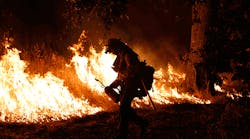Firefighting is urgent and stressful work, and decisions often are made without vital information on the hazards that exist.
To better protect emergency responders in these situations, the Occupational Safety and Health Administration has revised its manual, Fire Service Features of Buildings and Fire Protection Systems. https://www.osha.gov/Publications/OSHA3256.pdf
Recently, a Denver firefighter died after falling 25 feet through a skylight. and the revised manual from OSHA addresses this and many other types of building-related hazards for emergency responders.
“Structural fires present hazards that can result in serious injury or death for emergency personnel who respond to them,” said Assistant Secretary of Labor for Occupational Safety and Health Dr. David Michaels. “This revised manual offers practical and relevant information to help emergency responders stay safe while doing their jobs.”
The revised manual explains how fire personnel can resolve an incident sooner and in a safer manner if a building design is tailored to meet their needs during an emergency. The manual includes new chapters on water supply and integrating design elements to protect fire personnel during a building's construction, occupancy and demolition phases; new sections on energy conservation, emergency power, and room and floor numbering; and additional photos to help explain concepts. The manual is aimed at helping emergency responders during fires and other emergencies such as hazardous material releases, emergency medical care, non-fire rescues and terrorist attacks.
OSHA’s Fire Safety web page https://www.osha.gov/SLTC/firesafety/hazards.html contains additional training resources on fire hazards in the workplace, planning for workplace emergencies and evacuations, and preventing fire-related injuries.

